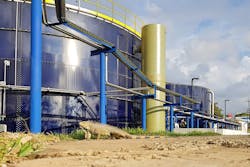Case study: Beverages company reduces footprint with WWTP
Florida Ice & Farm Company (FIFCO), a Costa Rican beer and malted beverages company, is reducing its environmental footprint with a new Global Water & Energy (GWE) wastewater treatment plant.
FIFCO, which produces more than 1.5 million hectoliters per year, including beer, spirits, juices, carbonated drinks, energy drinks, wine and dairy drinks, expects to double this by 2025. FIFCO’s installation of a new GWE wastewater treatment plant adds further sustainability credentials to the company.
To treat the wastewater from the brewing, FIFCO collaborated with GWE, a member of Global Water Engineering Group of Companies, to install a wastewater treatment plant at its facility in Heredia, Costa Rica. The process not only treats the wastewater efficiently but also converts organic matter into biogas, which can later be used to reduce the fossil fuel dependency of the company.
The system is designed to treat nearly 10,000 kilograms (kg) of organic load per day (kilograms COD/d) — with treatment efficiencies of approximately 95 percent. Note: Chemical oxygen demand (COD) is a measure of the organic content in the water.
GWE’s ANUBIX–B methane reactor installed at FIFCO allows the organic content to be converted to 4,800 Nm3/d (normal m3/day) of biogas, which is equivalent to 3,200 kg of heavy fuel oil/day. Such quantities of oil are worth approximately $515,000 a year, which can not only contribute to significant savings but further increase the sustainability of the company.
FIFCO can use the generated biogas to power boilers or combined heat and power (CHP) systems — or it can sell it back to the grid for a profit.
